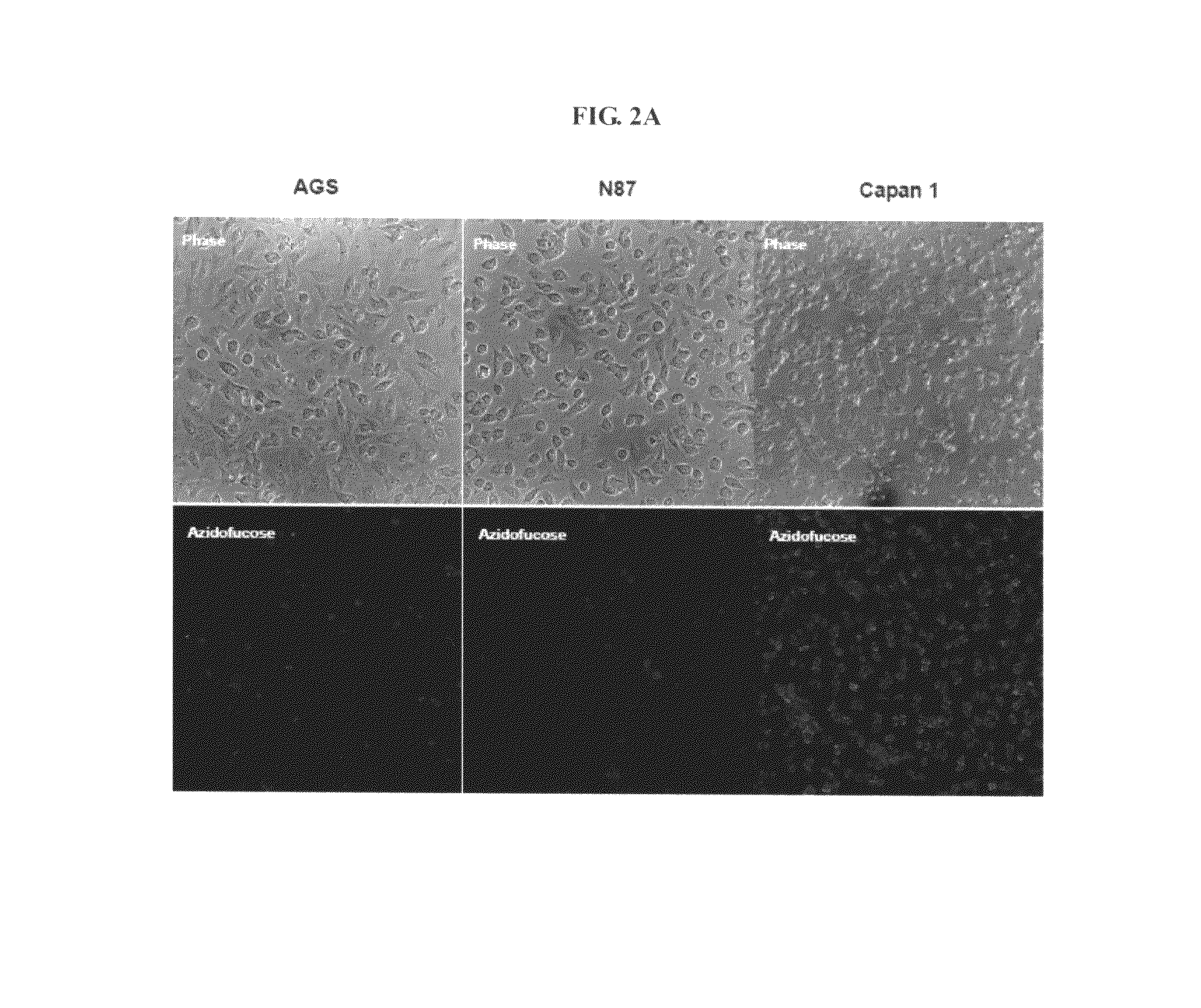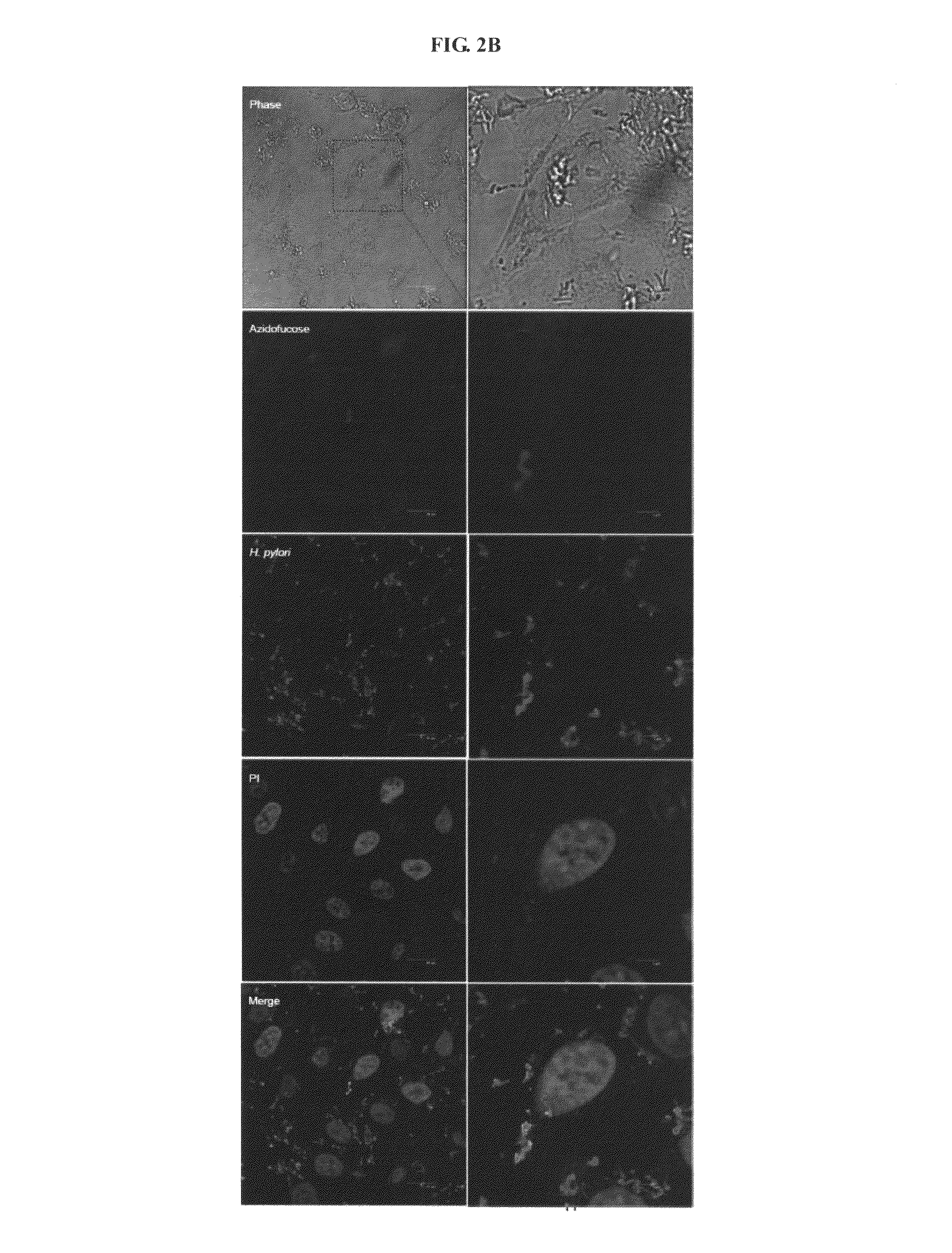Compositions and assays for treatment and diagnosis of helicobacter pylori infection and conditions
a technology of helicobacter pylori and assays, which is applied in the direction of drug compositions, chemical treatment enzyme inactivation, cardiovascular disorders, etc., can solve the problems of unclear information regarding difficult to define the microbial and host factors that determine the outcome of colonization,
- Summary
- Abstract
- Description
- Claims
- Application Information
AI Technical Summary
Problems solved by technology
Method used
Image
Examples
example 1
H. pylori Extracts 6-Azido-L-Fucose from Human Epithelial Fucosylated Glycoconjugates
[0136]A considerable proportion of H. pylori in the stomach is located at the epithelial mucosa (Schreiber S, et al. Proc. Natl. Acad. Sci. USA 2004, 101:5024-5029) where there are various fucose-containing oligosaccharides including Lewis antigens. To determine if H. pylori acquires L-fucose from host cells, similar to the interaction between B. thetaiotaomicron and small intestine cells (Hooper, et al. Proc. Natl. Acad. Sci. USA 1999, 96:9833-9838), the click chemistry-based fluorogenic labeling method developed by Wong and coworkers (Sawa M, et al. Proc. Natl. Acad. Sci. USA 2006, 103:12371-12376) was applied to detect fucosylated glycoconjugates. Fucosylated glycoconjugates in cultured whole cells were labeled with tetra-O-acetyl-6-azido-L-fucose. The acetyl groups improve cell permeability of the sugar probe, and they are later removed by non-specific esterases (to yield 6-azido-L-fucose) insid...
example 2
Detection of α-L-Fucosidase Activity from Host Cells in Response to H. pylori Infection
[0138]Transfer of L-fucose from host cells to H. pylori requires the presence of an α-L-fucosidase to specifically remove L-fucose from fucosylated glycans. To detect α-L-fucosidase activity, co-culture supernatants were concentrated approximately 10-fold and then subjected to an affinity chromatography column packed with α-L-fucosidase inhibitor-immobilized agarose beads [the inhibitor was 1-aminomethyl-1-deoxy-fuconojirimycin (FNJ)]. 4-Methylumbelliferyl-α-L-fucoside (4MU-fucoside) was utilized as the substrate to measure α-L-fucosidase activity in the resulting fractions. Substantial enzyme activity (309 U / 108 host cells; I U is defined as hydrolysis of 1 μmol of 4MU-fucoside per min at pH 5.5, 25° C.) was detected from the co-culture medium 4 h after inoculation at the ideal multiplicity of infection (MOI of ˜200:1). In contrast, no enzyme activity was detected in either uninfected Capan 1 cel...
example 3
Correlation of Secreted α-L-Fucosidase with H. pylori Adhesion
[0139]B. thetaiotaomicron produces a fucose-sensing protein that induces the host intestine to increase the expression of fucosylated glycans and secretes bacterial α-L-fucosidase to harvest L-fucose for import and metabolic processing (Hooper, et al., Proc. Natl. Acad. Sci. USA 1999, 96:9833-9838). In contrast, FUCA2 is secreted by the host in response to H. pylori infection, releasing L-fucose residues from the host cell surface. Because fucosylated blood group antigens are important for host-microbe interactions, the potential correlation between FUCA2 and H. pylori adhesion was investigated. The attachment of H. pylori was examined using confocal fluorescence microscopy by co-culturing H. pylori in mock-transfected Capan 1 cells or stable FUCA2-knockdown Capan 1 cells (Capan 1-FUCA2 K.D.). With a short-term incubation (4 h), the pathogen attached equally well to both mock-transfected and stable FUCA2-knockdown Capan 1...
PUM
| Property | Measurement | Unit |
|---|---|---|
| pH | aaaaa | aaaaa |
| pH | aaaaa | aaaaa |
| pH | aaaaa | aaaaa |
Abstract
Description
Claims
Application Information
 Login to view more
Login to view more - R&D Engineer
- R&D Manager
- IP Professional
- Industry Leading Data Capabilities
- Powerful AI technology
- Patent DNA Extraction
Browse by: Latest US Patents, China's latest patents, Technical Efficacy Thesaurus, Application Domain, Technology Topic.
© 2024 PatSnap. All rights reserved.Legal|Privacy policy|Modern Slavery Act Transparency Statement|Sitemap



